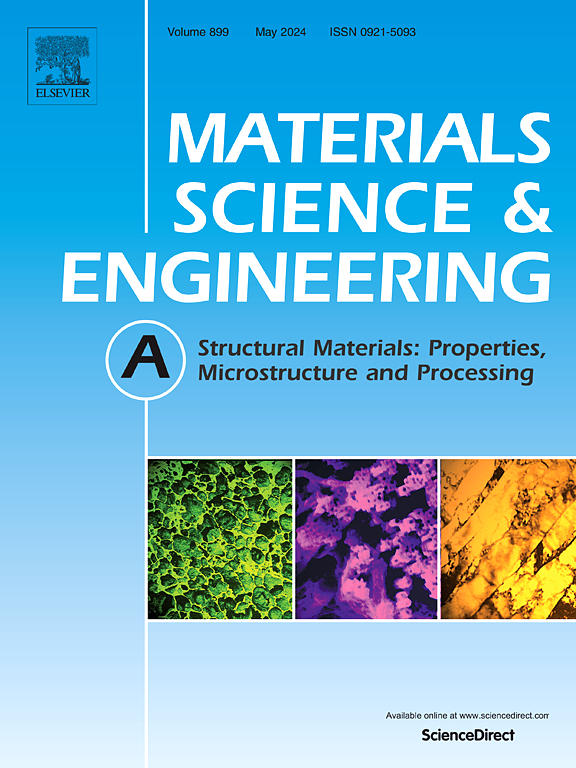室温和低温条件下AA5182 Al-Mg板材的成形极限和断裂机制
IF 6.1
2区 材料科学
Q1 MATERIALS SCIENCE, MULTIDISCIPLINARY
引用次数: 0
摘要
随需应变Al-Mg合金(如AA5182)的成形性受到波特文-勒沙特列(PLC)效应的限制,该效应表现为溶质-位错相互作用引起的动态应变时效(DSA)导致的锯齿状塑性流动。这种现象导致颈缩过早发生(即延展性降低)和表面缺陷,阻碍了这些合金在轻质结构部件中的广泛应用。研究了AA5182板材在室温(293 K)和低温(77 K)条件下单轴拉伸和Erichsen冲压成形的成形极限和断裂机理。低温拉伸断裂应变和流动应力分别提高了47%和91%,总体上满足了considre颈缩准则,完全防止了表面起皱。利用Erichsen冲孔试验首次获得了AA5182板材的低温成形极限图(FLDs)。与室温条件相比,单轴(拉伸)、平面应变和双轴拉伸应变路径的主应变极限分别提高了18%、43%和27%。通过光学显微镜观察全厚度微观结构证实,77 K PLC抑制阻止了与相对剪切面的不稳定相互作用,促进了更均匀的应变分布和薄片变薄。对断口边缘的扫描电镜观察显示,低温条件下,由于断裂延迟,裂纹形成的窝窝起始部位频率更高,窝窝面积增加了29%,相应地增加了空洞的形成和生长。平均成型后表面粗糙度也降低(提高)了5倍,代表了B级和a级表面处理之间的差异。本文章由计算机程序翻译,如有差异,请以英文原文为准。
Formability limits and fracture mechanisms in AA5182 Al-Mg sheets under room and cryogenic temperature conditions
The formability of in-demand Al-Mg alloys, such as AA5182, is constrained by the Portevin-Le Chatelier (PLC) effect, which manifests as serrated plastic flow due to dynamic strain aging (DSA) from solute-dislocation interactions. This phenomenon contributes to the premature onset of necking (i.e., reduced ductility) and surface defects, hindering the broader application of these alloys in lightweight structural components. The formability limits and fracture mechanisms for AA5182 sheets subjected to uniaxial tension and Erichsen punch forming were investigated under room temperature (293 K) and cryogenic (77 K) conditions. The cryogenic tensile fracture strain and flow stress increased by 47 % and 91 %, respectively, the Considère necking criterion was globally satisfied and surface wrinkling was fully prevented. Cryogenic forming limit diagrams (FLDs) were obtained for the first time for AA5182 sheet material using the Erichsen punch tests. The major strain limits increased by 18 %, 43 % and 27 % for uniaxial (drawing), plane strain and biaxial stretching strain paths, respectively, compared to room temperature conditions. Optical microscopy of the through-thickness microstructure confirmed that PLC suppression at 77 K prevented unstable interactions with opposing shear planes, promoting more uniform strain distribution and sheet thinning. Scanning electron microscopy of the fractured edges revealed a higher frequency of dimple initiation sites and 29 % greater dimpled area post-forming under cryogenic conditions due to delayed fracture and correspondingly increased void formation and growth. The average post-forming surface roughness was also reduced (improved) by a factor of 5, representing the difference between Class B and Class A surface finishes.
求助全文
通过发布文献求助,成功后即可免费获取论文全文。
去求助
来源期刊

Materials Science and Engineering: A
工程技术-材料科学:综合
CiteScore
11.50
自引率
15.60%
发文量
1811
审稿时长
31 days
期刊介绍:
Materials Science and Engineering A provides an international medium for the publication of theoretical and experimental studies related to the load-bearing capacity of materials as influenced by their basic properties, processing history, microstructure and operating environment. Appropriate submissions to Materials Science and Engineering A should include scientific and/or engineering factors which affect the microstructure - strength relationships of materials and report the changes to mechanical behavior.
 求助内容:
求助内容: 应助结果提醒方式:
应助结果提醒方式:


